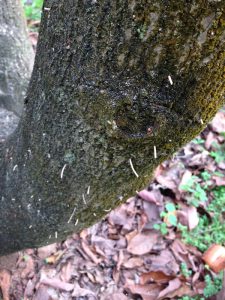In early August of 2017, a group of scientists and educators from the University of Florida traveled across the country to share their knowledge of a deadly disease with the avocado growers of California. California produces more than 80% of all of the avocados produced in the United States and the group from South Florida was delivering dire news of a potential danger to the lucrative California avocado industry.
The scientists and educators were hosted by the California Avocado Commission and spoke to growers in three different avocado growing regions: San Luis Obispo, Ventura, and Fallbrook. The group traveled from Homestead, Florida where most of the remaining percentage of domestic avocados are grown. South Florida is currently dealing with the devastating effects of a disease called laurel wilt. This disease is transmitted by tiny ambrosia beetles that bore into trees in the Laureaceae, or laurel family, in order to grow a fungus they feed to their young.
Laurel Wilt
The fungus, Raffaelea lauricola, is deadly to avocados and some related native species. Avocados are in the laurel family and severely overreact when exposed to the fungus. Infected trees try to wall off the fungus by blocking their xylem tissue, but the fungus quickly jumps the blockade. The tree responds with a more aggressive xylem wall which eventually leads to the tree’s death as it can no longer draw water and nutrients up to the canopy through the blocked xylem tissue. The disease has killed over 40,000 avocado trees since its arrival in South Florida in 2012. Laurel wilt entered the country in 2002 through Port Wentworth, Georgia and has since reached as far north as North Carolina and as far west as Texas. The disease has spread primarily on native species and has killed over 500,000,000 native swampbay and redbay trees. Laurel wilt gets its name as it affects trees in the laurel family and trees with the disease quickly turning once healthy leaves to a crispy brown in a matter of days. The disease works so fast that the leaves do not even have time to fall and will remain on the tree, a hallmark of laurel wilt.
The disease is vectored by the tiny aforementioned ambrosia beetles and can also move through root grafts. Most avocado groves in South Florida are over 20 years old with the roots of adjacent trees in the grove overlapping, and in many cases, grafted together, allowing elements to pass from tree to tree. Once laurel wilt gets into a grove though beetle infestation, the disease will often move right down a row killing tree after tree through adjacent root grafted trees.
Traveling Experts
The purpose of the group’s trip to California was to impart the knowledge they had compiled after years of dealing with this deadly disease. The group consisted of Dr. Jonathan Crane, a tropical fruit specialist, Dr. Daniel Carrillo, a tropical fruit entomologist, Jeff Wasielewski, an Extension agent, Dr. Randy Ploetz, a pathologist, Dr. Edward ‘Gilly’ Evans, an economist and Dr. Bruce Schaffer, an ecophysiologist. Each team member spoke about his area of expertise to the avocado growers and educators present at the meetings during the three stops of the trip.
What Was Learned
The take home message from the group was that if the disease ever made it to California, that the growers should already have a plan in place on how to collectively deal with the disease. Frequent scouting of groves and fast and efficient removal and destruction of trees is currently the best tool available to battle this disease. Removed trees need to be burned or chipped in place. The root system must also be broken and separated from adjacent trees so transmission by root grafting cannot be a problem.
The information flow was not only one way and the group from South Florida delighted in being educated about the growing techniques employed in California. The group visited several groves and the world famous Brokaw Nursery. Producers shared information on pruning techniques, water quality issues, root stock types, pest control, and harvesting methods.
The group would like to extend a special thank you to Dr. Timothy Spann, the research program director of the California Avocado Commission. Dr. Spann was an affable host and safely transported the group hundreds of miles all while maintaining a productive schedule and a great attitude. Thank you Dr. Spann, and may laurel wilt never make it California!




 0
0
